
Introduction: Navigating the Body’s Pathways for Precise Medication Delivery
The human body is an intricate marvel, a complex tapestry of tissues, vessels, and organs, each demanding a specific approach for the effective and safe delivery of therapeutic agents. At the forefront of this precise delivery system are injection needles, meticulously engineered instruments designed to navigate these diverse anatomical pathways. Understanding the distinct characteristics, applications, and optimal usage of intramuscular injection needles, subcutaneous injection needles, and intravenous needles is not merely a clinical preference; it is a fundamental prerequisite for safe, efficient, and therapeutically effective drug administration. This comprehensive guide will dissect the nuances of each injection route, providing healthcare professionals and aspiring practitioners with the essential knowledge to select the correct hypodermic needle for the intended anatomical plane, thereby ensuring optimal patient outcomes and minimizing potential complications. The precision inherent in these medical needles underscores their critical role in modern pharmacology and patient care, contributing to improved therapeutic outcomes.
Intramuscular Injections: Reaching Deep Muscle Tissue for Rapid Absorption
Intramuscular injection needles are specifically designed to deliver medication deep into deep muscle tissue, a site rich in blood supply that facilitates rapid and efficient absorption into the systemic circulation. Common anatomical sites for IM injections include the deltoid muscle (upper arm), the vastus lateralis muscle (thigh), and the gluteal muscles (buttocks). The selection of the appropriate injection needle for IM administration is crucial and depends on several factors, including the patient’s age, muscle mass, and the medication viscosity. Generally, IM needles are longer (typically 1 to 1.5 inches) and have a larger gauge (e.g., 20-25 gauge) compared to those used for other injection routes. This length ensures that the medication penetrates through the subcutaneous fat layer and is deposited directly into the muscle belly, preventing subcutaneous deposition which can lead to pain, irritation, or delayed absorption. The larger gauge accommodates more viscous solutions, allowing for smoother and quicker injection. This route is frequently utilized for vaccination campaigns, certain antibiotics, and other medications that require quick systemic effects or are irritating to more superficial tissues. Proper technique, including selecting the correct needle size and angle of insertion (typically 90 degrees), is paramount to avoid nerve damage, blood vessel puncture, or localized pain, thereby enhancing injection safety and therapeutic efficacy.

Subcutaneous Injections: Gentle Delivery into the Fatty Layer for Sustained Release
Subcutaneous injection needles are engineered for the delivery of medication into the adipose (fatty layer) tissue located just beneath the skin. This route is characterized by a slower and more sustained absorption rate compared to IM injections, making it ideal for medications that require a prolonged effect, such as insulin syringes, heparin, and certain hormones or vaccines. Common injection sites include the abdomen, the outer aspect of the upper arm, and the anterior thigh. Needles for SC injections are typically shorter (e.g., 5/8 inch to 1 inch) and have a finer gauge (e.g., 25-30 gauge) than IM needles. The shorter length minimizes the risk of penetrating muscle or bone, while the finer gauge significantly reduces patient discomfort, a crucial consideration for individuals requiring frequent self-injections. The technique often involves pinching the skin to elevate the subcutaneous tissue, allowing for accurate and safe medication deposition at a 45- to 90-degree angle, depending on the needle length and patient’s body habitus. Patient education on proper self-administration techniques, including site rotation to prevent lipodystrophy, is particularly important for individuals managing chronic conditions that necessitate daily SC injections, ensuring both patient comfort and optimal therapeutic outcomes.
Intravenous Injections: Direct Access to the Bloodstream for Immediate Impact
Intravenous (IV) injections involve the direct administration of medication into a vein, providing immediate access to the bloodstream and ensuring rapid systemic distribution and onset of action. This route is critical for emergency medicine situations, medications requiring precise and immediate effects, or for administering large volumes of fluids and blood products. IV injection needles, often referred to as catheters or cannulas, are inserted into superficial veins, commonly in the arm or hand. Once venous access is established, the needle is typically withdrawn, leaving a flexible plastic catheter in place to allow for continuous or intermittent medication administration. The gauge of IV needles varies widely (e.g., 14-27 gauge) depending on the size of the vein, the medication viscosity of the fluid, and the desired rate of infusion. Larger gauges are used for rapid fluid resuscitation or blood transfusions, while finer gauges are suitable for routine medication administration. While offering the fastest onset of action, IV injections demand meticulous aseptic technique to prevent infections and careful monitoring for complications such as phlebitis, infiltration, or extravasation. The direct entry into the circulatory system underscores the importance of precise drug calculations, careful administration, and continuous monitoring to ensure injection safety and optimal therapeutic outcomes.
Specialized Needles: Expanding the Horizon of Medical Interventions
Beyond the fundamental intramuscular injection needles, subcutaneous injection needles, and intravenous needles, the medical field employs a diverse array of specialized medical needles for advanced diagnostic and therapeutic procedures. For instance, spinal needles, characterized by their specific tip designs (e.g., pencil-point, Quincke), are used for lumbar punctures, spinal anesthesia, and epidural procedures, designed to minimize trauma and facilitate accurate placement within the spinal canal. Biopsy needles, often incorporating cutting edges or aspiration capabilities, are crucial for extracting tissue samples for pathological examination, aiding in disease diagnosis. Huber needles, with their unique non-coring tips, are specifically designed for accessing implanted ports and central venous access devices, preventing damage to the septum and ensuring long-term patency for patients requiring prolonged intravenous therapy. Dental needles are fine-gauge and short, tailored for precise local anesthetic delivery in the oral cavity. The continuous innovation in medical needle design reflects the evolving demands of medical science, pushing the boundaries of precision, safety, and efficacy in patient care across a multitude of specialties, thereby contributing to the broader field of medical innovation.


